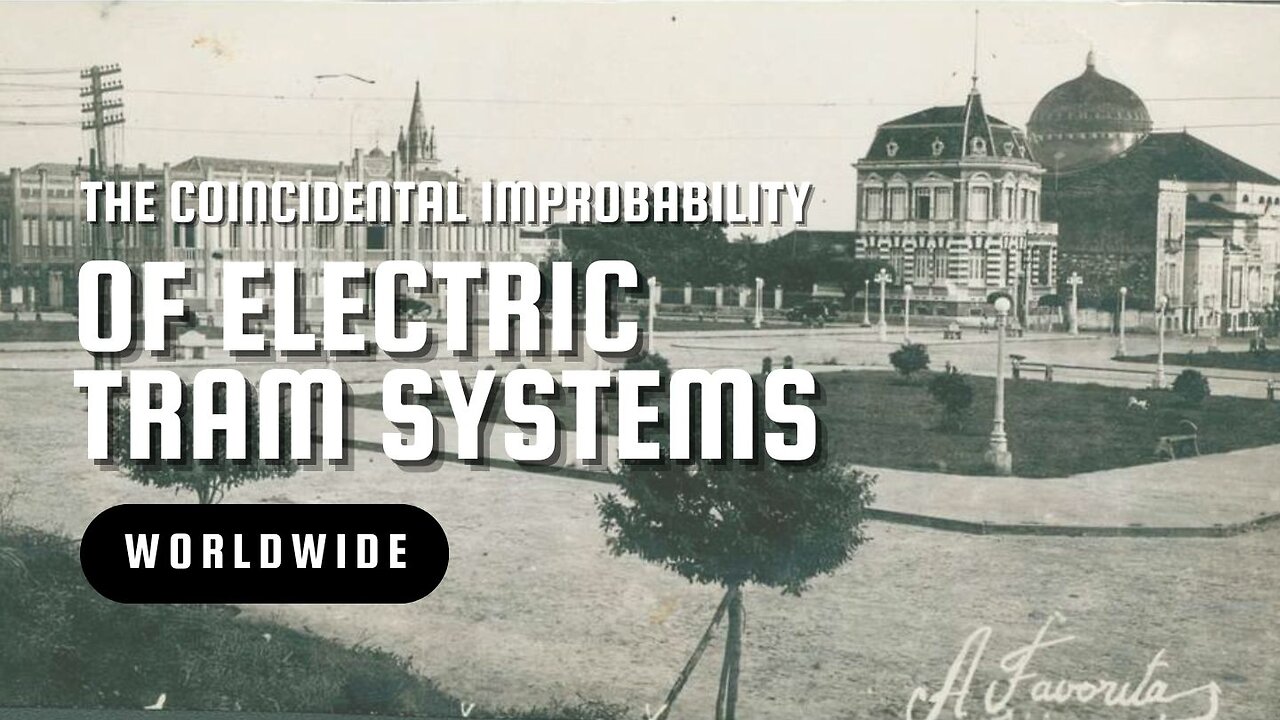Premium Only Content

The Coincidental Improbability of Electric Tram Systems Worldwide
We are told that the world's first electric tram system was invented in 1880 and tested near St. Petersburg, Russia. In North America, Montgomery, Alabama was the first location worldwide said to have a system of electric trams established in 1886. It was known as the "lightning route." (Alabama Power Co.)
The Capital City Street Railway, also known as the Lightning Route, was the first citywide system of streetcars established in Montgomery, Alabama, on April 15, 1886. This early technology was developed by the Belgian-American inventor Charles Joseph Van Depoele. Joseph Arthur Gaboury, a french Canadian from Quebec, was the owner of the horse-drawn system that was converted to electricity. One trolley route ended at the Cloverdale neighborhood. This early public transportation system made Montgomery one of the first cities to "depopulate" its residential areas at the city center through transportation-facilitated suburban development. The system operated for exactly 50 years, until April 15, 1936, when it was retired in a big ceremony and replaced by buses.
"I started to notice a close connection in my research between not only trams, trains, canals, and star forts, but the incredible similarity between these systems all over the world. Historical tram systems, also known as streetcars, keep cropping up, so this video is dedicated to this particular subject!"
SOURCE
Michelle Gibson
If you like my work, I would be appreciative of your support of any amount at Patreon: www.patreon.com/piercingtheveilofillusion
RUBBER BOOM IN MANUAS, BRAZIL
1848. Manuas, Brazil. Electric Trams & Streetlights. In the Middle of The Amazon Rain Forest. No Road Until 1963!
Manaus was at the center of the Amazon region's rubber boom during the late 19th century. For a time, it was "one of the gaudiest cities of the world". Historian Robin Furneaux wrote of this period, "No extravagance, however absurd, deterred" the rubber barons. "If one rubber baron bought a vast yacht, another would install a tame lion in his villa, and a third would water his horse on champagne." The city built a grand opera house, with vast domes and gilded balconies, and using marble, glass, and crystal, from around Europe. The opera house cost ten million (public-funded) dollars. In one season, half the members of one visiting opera troupe died of yellow fever. The opera house, called the Teatro Amazonas, was effectively closed for most of the 20th Century.
When the seeds of the rubber tree were smuggled out of the Amazon region to be cultivated on plantations in Southeast Asia, Brazil and Peru lost their monopoly on the product. The rubber boom ended abruptly, many people left its major cities, and Manaus fell into poverty. The rubber boom had made possible electrification of the city before it was installed in many European cities, but the end of the rubber boom made the generators too expensive to run. The city was not able to generate electricity again for years.
-
![The Man In The Red Cap Ushers In The Purification | Hopi Prophecy [Timestamp 16:35]](https://1a-1791.com/video/s8/1/E/k/O/v/EkOvv.0kob-small-The-Man-In-The-Red-Cap-Ushe.jpg) 26:46
26:46
The Aquarius Bus
2 months agoThe Man In The Red Cap Ushers In The Purification | Hopi Prophecy [Timestamp 16:35]
1.46K5 -
 37:44
37:44
Glenn Greenwald
13 hours agoGlenn On Tearing Down the Military Industrial Complex, Exposing Pro-Israel Indoctrination, and More | SYSTEM UPDATE #411
106K120 -
 4:04:20
4:04:20
Nerdrotic
12 hours ago $49.47 earnedAmazon Takes 007! Hollywood is Lost, Disney Cancels WHO? | Friday Night Tights 342 /w ItsAGundam
167K38 -
 43:27
43:27
Tucker Carlson
11 hours agoRay Dalio: America’s Hidden Civil War, and the Race to Beat China in Tech, Economics, and Academia
161K184 -
 56:56
56:56
Candace Show Podcast
12 hours agoEXCLUSIVE: Taylor Swift Will Be Deposed. | Candace Ep 150
187K147 -
 1:03:52
1:03:52
IsaacButterfield
8 hours ago $4.34 earnedRepublican Vs 25 Transgender Activists | Jewish Outrage | Lizzo Loses All the Weight
55.7K14 -
 1:10:23
1:10:23
Edge of Wonder
12 hours agoChinese Biochips Hacking Minds? Quantum Control & Journey Song Mandela Effect
79.3K9 -
 2:15:46
2:15:46
Quite Frankly
15 hours ago"Ghosts, Robotics, and OBE's" ft. Dr. Albert Taylor 2/21/25
73.4K18 -
 55:52
55:52
LFA TV
1 day agoMaking Germany Great Again | TRUMPET DAILY 2.21.25 7PM
49.1K9 -
 1:52:26
1:52:26
2 MIKES LIVE
11 hours ago2 MIKES LIVE #183 Open Mike Friday with Hannah Faulkner and Adelia Kirchner!
35.8K